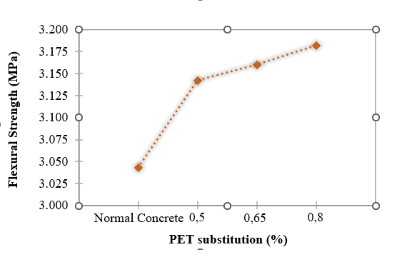Influence Utilization Waste Plastic Polyethylene Terephthalate on the Flexural Strength of Concrete with Use East Kalimantan Aggregate
DOI:
https://doi.org/10.24036/cived.v10i3.443Keywords:
Concrete, Flexural Strength, PET, East KalimantanAbstract
Environmental pollution is still an issue that cannot be ignored. This type of waste causes environmental pollution due to its large and difficult to be recycled is Polyethylene Terephthalate (PET) plastic. So it is important to make an effort to utilize the plastic. On the other hand in the world of construction, the use of concrete increases every day causing the need for many new material sources in order to cover the needs of concrete mixtures. One of the abundant sources of aggregate is East Kalimantan aggregate but has not been used much. so combining East Kalimantan aggregate and PET plastic as a concrete constituent material becomes interesting to be analyzed, especially to determine the characteristics of the flexural strength of concrete. The flexural strength is based on SNI 03-4431-2011 method and tested at the age of 14 and 28 days. PET plastic chopped to a size of 5 cm long and 1-3 mm wide with variations 0.5%; 0.65%; and 0.8% of the weight of sand. The total number of samples is 24 blocks size of 15 × 15 × 60 cm. The results indicate that the flexural strength characteristics of concrete using local East Kalimantan aggregates and using PET plastic as a partial substitute for fine aggregate increased as the number of PET substitutions. Concrete without PET plastic has 3.187 MPa. In comparison with to normal concrete, 0.5% PET substitution increased by 3.07%, 0.65% PET variation increased by 3.63% and 0.8% PET variation increased by 4.32%.
Downloads
References
IF Bachri, "Implementation of the Waste Management Program in dealing with Environmental Pollution in Bone Regency, South Sulawesi Province," 2023.
I.m. OD Putra, S. I Nyoman Gede and S. Luhputu, "Management of Household Plastic Waste, in the Context of Preventing Environmental Pollution (Study in the Pedungan Subdistrict, South Denpasar District, Denpasar City)," Journal of Construction Law, pp . 86-90, 2021.
J. Jambeck, "The Plastic Tide," 2018.
AM Indriani, G. Utomo and M. Rizqy, "Time and Cost Performance Analysis of Construction Projects Using the Earned Value Analysis Method," Journal of Geo Economics, pp. 128-137, 2022.
Rahmat, I. Hendriyani and MS Anwar, "Analysis of Compressive Strength of Concrete Using Reduced Water and Accelerated Admixture," pp. 205-218, 2016.
F. Hidayat and AP Melinda, "Experimental Study of the Use of Lokan Shell Ash on Concrete Strength," CIVED, vol. 9, pp. 268-278, 2022.
AM Indriani, G. Utomo and MR Syahputra, "The Effect of Wet Dry Cycles on the Mechanical Behavior of Biocementation Stabilized Clay Soil with Bacillus Subtilis Bacteria," CIVED, vol. 10, pp. 416-427, 2023.
A. Sugianto and AM Indriani, "The Effect of the Ratio of Compressive Stress Block Height and Effective Height on the Flexure of Single Reinforced Beams," JTT (Jurnal of Integrated Technology), pp. 100-107, 2017.
AM Indriani, A. Sugianto and F., "Analysis of the Use of Split Long Ikis Stone on the Characteristics of AC-WC Mixtures (Asphal Choncrete-Wearing Course)," JTT ( Jurnal of Integrated Technology), pp. 87-92, 2015.
TA Amibo, BB Abreham and AA Desalegn, "Polyethylene Terephthalate Waste As A Partial Replacement For Fine Aggregates In Concrete Mix, Case Of Jimma Town, South West Ethiopia," Sriwijaya Journal Of Environment, pp . 20-35, 2021.
K. Singh, "Partial replacement of cement with polyethylene terephthalate fiber to study its effect on various properties of concrete," Elsevier, 2020.
R. Umasabor and D. Samuel.C, "The Effect Of Using Polyethylene Terephthalate As An Additive On The Flexural And Compressive Strength Of Concrete," Heliyon, 2020.
DR Basri and Z. Ahmad, "The Effect of Plastic Bottle Waste (Melt) as an Additive Material on the Flexural Strength of Concrete," Rab Construction Research Journal, pp. 67-77, 2019.
M. Shamsudin, N. Hamid and M. Fauzi, "Compressive and Flexural Strength of Recycled Concrete Containing," pp. 13-20, 2021.
J. Black, "The Use of Recycled Polyethylene Terephthalate as a Partial Replacement for Sand on the Mechanical Properties of Structural Concrete," The Plymouth Student Scientist - Volume 13, pp. 143-172, 2020.
Asrar, B. Erniati, G. Sri, R. Fatmawati and AS Ritnawati, "Utilization of Recycled Polyethylene Terephthalate (PET) Plastic Waste as a Substitute for Coarse Aggregate in Concrete," Kacapuri Journal, pp . 156-164, 2020.
R. Kinasz, "Examination of Concrete Elements Bending Strength Reinforced by Polyethylene Terephthalate (PET) Waste," 2019.
K. Achmad and Sunarno, "Compressive Strength of Mortar and Cylinder in Concrete Using a Combination of Local Samboja Sand Material with Palu Pair," 2019.
K. Achmad, "Kandilo Sand and Petangis Gravel as Local Grogot Soil Materials in Concrete Mixtures," 2015.
H. Apriyanto, "Shear Capacity of Reinforced Concrete Beams with Polypropylene Fiber is 4% of the Concrete Volume," pp. 161-172, 2010.
F. Pelisser, ORK Montedol, PJP Gleize and HR Roman, "Mechanical properties of recycled PET fibers in concrete," 2012.
E. Calosa, P. Sasana and et al, "Utilization of Used Plastic Packaging Glass Waste to Increase the Strength of Concrete Mixes as a Rigid Pavement Material," pp. 394-406, 2022.
MR Yogi and R. Yogie, "Utilization of Plastic Bottle Fibers on Compressive Strength and Flexural Strength in Making Lightweight Concrete Panels Using Electric Arc Furnace Slag (EAFS) as a Sand Substitute," 2020.
RB Kassa and C. Kanali, "Flexural Performance Evaluation of Polyethylene Terephthalate Fiber Reinforced Concrete with Fly Ash as a Partial Cement Replacement," International Journal of Engineering Research and Technology, pp. 1435-1440, 2019.

Downloads
Published
How to Cite
Issue
Section
License
Copyright (c) 2023 Dinda Indah Damayanti, Andi Marini Indriani, Gunaedy Utomo

This work is licensed under a Creative Commons Attribution 4.0 International License.







2.jpg)
